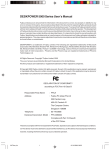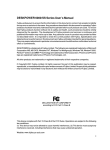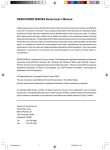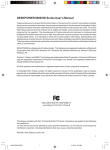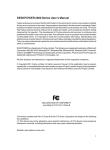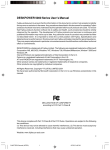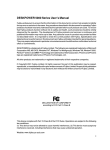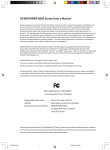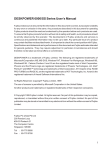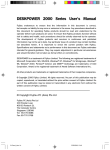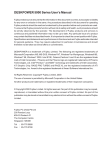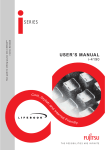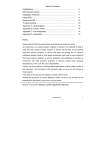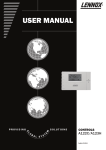Download DESKPOWER 6000/SS Series User`s Manual
Transcript
DESKPOWER 6000/SS Series User’s Manual Fujitsu endeavours to ensure that the information in this document is correct, but accepts no liability for any error or omission in the same. Any procedures described in this document for operating Fujitsu products should be read and understood by the operator before such products are used. To ensure that Fujitsu products function without risk to safety and health, such procedures should be strictly observed by the operator. The development of Fujitsu products and services is continuous and published information may not be up to date. Any particular issue of a product may contain facilities not described herein. It is important to check the current position with Fujitsu. Specifications and statements as to performance in this document are Fujitsu estimates intended for general guidance. They may require adjustment in particular circumstances and should therefore not be taken as formal offers or commitments. DESKPOWER is a trademark of Fujitsu Limited. The following are registered trademarks of Microsoft Corporation: MS, MS-DOS, Windows® NT, Windows® 98, Windows® 2000. Intel 810/810E, Celeron, Pentium II and III are the registered trade mark of Intel Corporation. Phoenix and the Phoenix logo are registered trademarks of Phoenix Technologies, Ltd. Intel® Pentiumw and MMX™ technology are trademarks of Intel Corporation. All Rights Reserved. Copyright© Fujitsu Limited, 2000 The use of screens is permitted by Microsoft Corporation in the United States. All other products are trademarks or registered trademarks of their respective companies. All rights reserved. No part of this publication may be copied, reproduced, or translated without the prior written consent of Fujitsu Limited. No part of this publication may be stored or transmitted in any electronic form without the written consent of Fujitsu Limited. DECLARATION OF CONFORMITY according to FCC Part 15 Class B Responsible Party Name : FPCA Address : Fujitsu PC (Asia) Pte Ltd 200 Pandan Loop #05-03, Pantech 21 The Computer Centre Singapore 128388 Telephone : 65-776 0688 Declares that product: Model : FPC-S80000 Complies with Part 15 Class B of the FCC Rules. This device complies with Part 15 Class B of the FCC Rules. Operations are subject to the following two conditions: (1) This device must not be allowed to cause harmful interference, (2) This device must accept any interference received, including interference that may cause undesired operation. *00-Magus Intro 1 01/11/2000, 15:10 IMPORTANT SAFETY INSTRUCTIONS 1. Read these instructions carefully. Save these instructions for future reference. 2. Follow all warnings and instructions marked on the product. 3. Unplug this product from the wall outlet before cleaning. Do not use liquid cleaners or aerosol cleaners. Use a damp cloth for cleaning. 4. Do not use this product near water. 5. Do not place this product on an unstable cart, stand, or table. The product may fall, causing serious damage to the product. 6. Slots and openings in the cabinet and the back or bottom are provided for ventilation; to ensure reliable operation of the product and to protect it from overheating, these openings must not be blocked or covered. The openings should never be blocked by placing the product on a bed, sofa, rug, or other similar surface. This product should never be placed near or over a radiator or heat register, or in a built-in installation unless proper ventilation is provided. 7. This product should be operated from the type of power indicated on the marking label. If you are not sure of the type of power available, consult your dealer or local power company. 8. This product is equipped with a 3-wire grounding-type plug, a plug having a third (grounding) pin. This will only plug into a grounding-type power outlet. This is a safety feature. If you are unable to insert the plug into the outlet, contact your electrician to replace your obsolete outlet. Do not defeat the purpose of the grounding-type plug. 9. Do not allow anything to rest on the power cord. Do not locate this product where persons will walk on the cord. 10. If an extension cord is used with this product, make sure that the total ampere rating of the equipment plugged into the extension cord does not exceed the extension cord ampere rating. Also, make sure that the total rating of all products plugged into the wall outlet does not exceed 15 amperes. 11. Never push objects of any kind into this product through cabinet slots as they may touch dangerous voltage points that could result in a fire or electric shock. Never spill liquid of any kind on the product. 12. Do not attempt to service this product yourself, as opening or removing covers may expose you to dangerous voltage points or other risks. Refer all servicing to qualified service personnel. *00-Magus Intro 2 01/11/2000, 15:10 13. Unplug this product from the wall outlet and refer servicing to qualified service personnel under the following conditions: a. When the power cord or plug is damaged or frayed. b. If liquid has been spilled into the product. c. If the product has been exposed to rain or water. d. If the product does not operate normally when the operating instructions are followed. Adjust only those controls that are covered by the operating instructions since improper adjustment of other controls may result in damage and will often require extensive work by a qualified technician to restore the product to normal condition. e. If the product has been dropped or the cabinet has been damaged. f. If the product exhibits a distinct change in performance, indicating a need for service. 14. CAUTION. When replacing the battery, be sure to install it with the polarities in the correct position. There is a danger of explosion if the battery is replaced with an incorrect type or is mistreated. Do not recharge, disassemble or dispose of in fire. Replace only with the same or equivalent type recommeded by the manufacturer. Dispose of the used battery according to the manufacturer’s instructions. 15. Use only the proper type of power supply cord set (provided in your accessories box) for this unit. It should be a detachable type: UL listed/CSA certified, BS1363,ASTA,SS145 certified, rated 10A 250V minimum, VDE approved or its equivalent. Maximum length is 15 feet (4.6 meters). *00-Magus Intro 3 01/11/2000, 15:10 ■ Greetings We thank you for purchasing the Fujitsu DESKPOWER 6000/SS personal computer. The DESKPOWER 6000/SS is a desktop-type personal computer with a space-saving design. This manual explains how to use the hardware of the DESKPOWER 6000/SS. Please read this manual carefully to ensure correct use of the PC. This unit may malfunction if the power source is interrupted suddenly, for example, due to lightning. Fujitsu recommends the use of an AC non-interruptible power supply unit. (Based on guidelines for the prevention of sudden voltage interruptions by Japan Electronic Industry Development Association (JEIDA). This unit is class B information technology equipment based on the Voluntary Control Council for Interference (VCCI) standard by Information Technology Equipment and may create interference if used near radio or television receivers. Use the unit in accordance with information provided in the manual. This unit conforms to the Personal Computer Industry Standard (PC-11-1988) of the Japan Electronic Industry Development Association (JEIDA). This unit conforms to the harmonic guideline. Because this product includes cargo based on the “Foreign Exchange and Foreign Trade Control Act,” the export of this product may require permission in accordance with said act. Fujitsu, who is a participant of the International Energy Star Program, determines that this product conforms to the International Energy Star Program Standard. The International Energy Star Program is an international program for promoting energy conservation of office equipment such as computers and strives to develop and promote products capable of efficient energy use. This program is open to all manufacturers, and the products to be developed include computers, displays, printers, facsimiles, and copy machines. The same standard and markings ( ) are used among participating countries. The energy-saving function of this product, however, may not be applicable because of limitations with the operating system (such as Windows NT). *00-Magus Intro 4 01/11/2000, 15:10 ■ Conventions used in this manual ● Warning icons Various icons and icon/word combinations are used in this manual to encourage users to use the equipment so as to minimize personal risk and prevent property damage. The icons are explained as follows. The user should be familiar with the icons before responding to the corresponding instructions. Indicates a hazardous situation that could result in fatal or serious wound WARNING if the correct procedure is not applied. Indicates a hazardous situation that could result in personal injury and/or CAUTION property damage if the correct procedure is not applied. The following icons are also used with the above icon/word combinations to prevent personal injury and/or property damage. The icon Electric shock that indicates the corresponding instruction is a warning. The illustration displayed inside or beside the icon shows what the warning actually means. The icon that indicates the corresponding instruction is a banned action. The illustration displayed inside or beside the icon shows what is actually banned. The icon ● that indicates the corresponding instruction is a command to proceed. The illustration displayed inside or beside the icon shows what to proceed. ● Representing keys and use thereof In the text of the manual, keyboard keys are represented using only necessary characters as shown below. Example: [Ctrl] key, [Enter] key, and [→] key When more than one key is to be pressed simultaneously, the keys are represented using “+” between keys as shown below: Example: [Ctrl] + [F3] and [Shift] + [↑] ● Representing buttons Buttons displayed on the screen are enclosed in square brackets, [and], as shown below: Example: [OK] ● Command entries In the text of the manual, a command is represented as shown below: diskcopy a: a: ↑ ↑ *00-Magus Intro 5 01/11/2000, 15:10 A blank (shown with [↑]) between characters indicates that the [Space] key (long bar on the front of the keyboard) is to be pressed once. Command names are represented in lowercase but may be entered using uppercase letters. ● Conventions used in the text of the manual The symbols used in the text of the manual have meanings as explained below: Point Help Point indicates information necessary to run hardware or software. Help indicates information explaining how to terminate an incorrect operation or troubleshoot. ● Screen display examples Screen displays provided in this manual are examples and may be different from those (including file names) actually appearing on the display screen. ● Illustrations Illustrations in this manual are an example using (mainly) the DESKPOWER 6000/SS (CD-ROM drive-equipped model) and may be different from those actually appearing on your PC screen depending on the model type and options installed. ● Referencing products In this manual, products are described using abbreviations as listed below: Windows 98 refers to Microsoft® Windows® 98 operating system. Windows Me refers to Microsoft® Windows® Millennium operating system. Windows 2000 refers to Microsoft® Windows® 2000 operating system. Windows NT refers to Microsoft® Windows NT® Workstation operating system Version 4.0. The terms “your PC,” “the PC,” “your PC main unit,” and “the PC main unit” refer to the DESKPOWER. *00-Magus Intro 6 01/11/2000, 15:10 ■ Warning and caution labels The PC bears warning and caution labels as shown below. The warning and caution labels must not be removed or damaged. WARNING Before disassembling the unit and installing a built-in option, switch off Electric shock DESKPOWER TN peripherals and unplug all power MODEL FPC-S80000 P/N CP070180-01 cords from respective outlets to 200-240V 1.75A 50/60Hz 100-120V 3.5A 50/60Hz the PC and all connected FC UL prevent electric shock. LISTED UL1850 7J61 MADE IN JAPAN(J) FUJITSU LIMITED Attention 115V of voltage switch in the power supply corresponds to 100-200V 230V of voltage switch in the power supply corresponds to 200-240V WARNING ● Before mounting or dismounting an optional unit in/from your PC, switch off the PC and all connected units and unplug all power cords from respective outlets to prevent electric shock. *00-Magus Intro 7 01/11/2000, 15:10 Manual configuration Chapter 1 Introduction This chapter provides basic information on the PC, such as the names and functions of individual parts, and also explains the basic operation of the PC, such as turning the power on or off. Chapter 2 Hardware This chapter provides basic information on how to handle the components installed (or can be installed) on the PC. Chapter 3 Troubleshooting This chapter explains how to respond to a problem occurring in the PC.Read wherever applicable. Chapter 4 Technical Information This chapter explains the specifications and other information relating to this PC. *00-Magus Intro 8 01/11/2000, 15:10 Contents CHAPTER 1 1 Introduction Part Names and Functions .............................................................. 2 Front of the PC unit .......................................................................................... 2 Back of the PC unit .......................................................................................... 4 Inside the PC unit ............................................................................................. 6 Motherboard ..................................................................................................... 7 2 Installation ......................................................................................... 8 Installation area ............................................................................................... 8 Mounting the feet ............................................................................................. 8 Example of installation ................................................................................... 11 Horizontal placement ..................................................................................... 11 3 Connection ...................................................................................... 12 Connecting the display, keyboard, mouse, and LAN cables .......................... 13 Connecting the power cable ........................................................................... 16 4 Turning On the Power ..................................................................... 18 Notes on power-on ......................................................................................... 18 Turning on the power ...................................................................................... 19 5 Turning Off the Power .................................................................... 20 Notes on power-off ......................................................................................... 20 Turning off the power ...................................................................................... 20 6 Resetting ......................................................................................... 23 7 CD ..................................................................................................... 25 Resetting the PC ............................................................................................ 23 Notes on handling .......................................................................................... 25 Inserting or removing a CD ............................................................................ 26 8 Floppy Disk ..................................................................................... 28 Notes on handling .......................................................................................... 28 Inserting or removing a floppy disk ................................................................ 28 9 Hard Disk ......................................................................................... 30 Notes on handling the hard disk ..................................................................... 30 10 Mouse .............................................................................................. 31 Using the mouse ............................................................................................ 31 CHAPTER 2 1 Hardware Before Installing a Peripheral Device ............................................ 34 What are peripheral devices? ........................................................................ 34 Notes on handling .......................................................................................... 35 Location for installation .................................................................................. 36 Removing the upper cover ............................................................................. 37 *00-Magus Intro 9 01/11/2000, 15:10 2 Increasing the Memory Capacity ................................................... 38 Location of memory modules ......................................................................... 39 Applicable memory modules .......................................................................... 39 Installing/removing memory modules ............................................................. 40 3 Installing Expansion Cards ............................................................ 44 Applicable expansion cards ............................................................................ 45 Installing an expansion card ........................................................................... 46 CHAPTER 3 1 CHAPTER 4 1 Troubleshooting Problems ......................................................................................... 50 Technical Information Maintenance of the Hardware ........................................................ 54 Maintenance of the PC unit ............................................................................ 54 Maintenance of the keyboard ......................................................................... 54 Maintenance of CDs ....................................................................................... 54 Maintenance of the mouse ............................................................................. 55 Cleaning of the floppy disk drive .................................................................... 56 2 3 4 5 Preventing Television or Radio Interference ................................ 57 Security of the Case ....................................................................... 58 Diagnostic Test of LAN Function ................................................... 59 Standard Specifications ................................................................. 60 Specifications of PC unit ................................................................................ 60 LAN adapter specifications ............................................................................ 61 Sound specifications ...................................................................................... 61 Connector specifications ................................................................................ 62 6 Other Precautions ........................................................................... 67 Disposal ......................................................................................................... 67 USB (Windows 95/98/2000/Me model) .......................................................... 67 USB keyboard (Windows 98 model) .............................................................. 67 Addition of LAN adapter ................................................................................. 68 Wake up On LAN ........................................................................................... 68 Precautions on using display ......................................................................... 68 Precautions on using analog LCD .................................................................. 68 Adjustment of analog display screen position ................................................ 68 Display of video memory capacity .................................................................. 68 Connection of display ..................................................................................... 68 Replacement of display .................................................................................. 69 Installation of core .......................................................................................... 70 Intel® processor serial number ....................................................................... 70 Power-saving function .................................................................................... 70 Peripheral devices/cables ............................................................................... 70 Mouse with scroll (wheel) function ................................................................. 70 *00-Magus Intro 10 01/11/2000, 15:10 CHAPTER 1 Introduction *01-Magus (01-17) 1 01/11/2000, 15:10 1 Part Names and Functions This section explains the names and functions of the parts of the PC unit and the motherboard. ■ Front of the PC unit 1 2 3 9 10 11 4 5 6 12 7 13 8 14 15 2 *01-Magus (01-17) 2 01/11/2000, 15:10 1 Power switch Press this switch to turn on the PC or set the system to the standby mode. 2 Power lamp This lamp lights up when the PC is on. It lights up in green when the PC is in operation and in orange when the PC is in the standby (powersaving) mode. 3 Hard disk access lamp This lamp lights up while the hard disk is accessed. 4 Volume Use this control to adjust the volume of the speaker or headphones. Turn this control upward to turn up or downward to turn down. 5 Headphone jack When listening to sound output from the PC or a music CD with headphones, plug them to this jack. 6 Microphone jack Plug a microphone to this jack. 7 USB connector Slide the cover down and connect a USB peripheral device. 8 Smart card bay Use this bay to install a smart card reader/writer. 9 Busy lamp (CD-ROM pre-installed model) This lamp lights up while data is read from the CD-ROM drive or a music CD is played. 10 CD-ROM drive (CD-ROM pre-installed model) Insert a CD-ROM into this drive to read data or programs, or insert a music CD for playback. 11 Eject button (CD-ROM pre-installed model) Press this button to insert or remove a CD-ROM or music CD. This button can be used when the PC is on. Do not press this button when the Busy lamp is on. 12 Floppy disk eject button Press this button to remove a floppy disk from the floppy disk. Do not press this button when the floppy disk access lamp is on. 13 Floppy disk drive This drive accommodates a floppy disk for writing and reading data. 14 Floppy disk access lamp This lamp lights up while the floppy disk is accessed. 15 Foot Use this foot to install the PC. It is designed to prevent the PC from falling when it is vertically installed. 3 *01-Magus (01-17) 3 01/11/2000, 15:10 ■ Back of the PC unit 1 5 6 2 7 3 8 9 10 4 11 12 13 14 4 *01-Magus (01-17) 4 01/11/2000, 15:10 1 Venthole An opening provided to let heat go out of the PC. 2 Inlet Connect the power cable of the PC unit to this connector. 3 Outlet Connect the power cable of the display to this outlet. 4 Expansion slot Insert an optional expansion card to this slot. This slot accommodates a PCI card. 5 Mouse connector Connect a mouse. 6 Keyboard connector Connect the keyboard. 7 Serial connector Connect the cable of an RS-232C device. 8 Parallel connector Connect the cable of a printer or scanner. 9 CRT connector Connect the cable of an analog RGB display. 10 DVI connector Connect the cable of a DVI display. 11 LAN connector Connect the LAN cable. 12 USB connector Connect a USB peripheral device. 13 LINE IN terminal A terminal for sound input. Connect the output terminal of audio equipment to this terminal. 14 LINE OUT terminal A terminal for sound output. Connect the input terminal of audio equipment to this terminal. When connecting speakers, use those with a built-in amplifier. 5 *01-Magus (01-17) 5 01/11/2000, 15:10 ■ Inside the PC unit 1 2 3 1 Expansion slot Insert an optional expansion card to this slot. This slot accommodates a PCI card. 2 Power supply unit 3 Internal hard disk This is an IDE-compliant hard disk. 6 *01-Magus (01-17) 6 01/11/2000, 15:10 ■ Motherboard 1 2 5 6 4 1 2 3 CPU DIMM slots Memory modules are inserted into these slots. When seen from the front of the PC unit, DIMM1 and DIMM2 are arranged in this order from the right. 3 Secondary IDE connector (IDE2) A standard CD-ROM is connected (CD-ROM pre-installed model). 4 Primary IDE connector (IDE1) A standard hard disk is connected. 5 Internal battery This battery provides power to retain information on date and time, and settings made in BIOS Setup. The life is about 5 years under normal use (8 hours a day). 6 Floppy connector (FDD) 7 *01-Magus (01-17) 7 01/11/2000, 15:10 2 Installation This section explains how to install your PC and also provides note on using the PC. ■ Installation area Do not install the PC in the following areas: - Areas that are humid, dusty, or subjected to oil mist. - Poorly ventilated areas - Areas where fire is used - Bathrooms and other areas where water may splash - Areas exposed to direct sunlight or near a heater and other areas with high temperatures - Areas with temperatures below 10°C - Areas where you may trip on a cable. - Areas subjected to a strong magnetic field, such as near a television or speaker. - Unstable areas with violent vibration or on a slanted surface ■ Mounting the feet ● Vertical placement • Double feet Take the following steps to place your PC vertically off a wall. 1 Assemble the feet. 8 *01-Magus (01-17) 8 01/11/2000, 15:10 2 Mount the feet on the PC unit. Fix the feet by tightening screws into two holes marked “DOUBLE” on the bottom of the feet. • Single foot Take the following steps to place your PC vertically on a wall. 1 2 Disassemble the feet. Mount one of the feet on the PC unit. Fix the foot by tightening screws into two holes marked “SINGLE” on the bottom. Mount the foot so that the right side of the vertically placed PC unit faces a wall. 9 *01-Magus (01-17) 9 01/11/2000, 15:10 ● Horizontal placement 1 Disassemble the feet. 2 Place the PC unit on the disassembled feet. 10 *01-Magus (01-17) 10 01/11/2000, 15:10 ■ Example of installation Install your PC as shown in the figures below. The PC unit can be installed either vertically or horizontally. Pay attention not to block the ventholes. ● Vertical placement Display PC main unit Keyboard Foot Mouse ■ Horizontal placement You can place a display (17 inches or smaller, weighing 19 kg or less) on the PC unit. Display PC main unit Keyboard Mouse Point The remaining part of this manual assumes vertical placement. When you place the PC unit horizontally, be careful about geometrical difference. 11 *01-Magus (01-17) 11 01/11/2000, 15:10 3 Connection Connect the display, keyboard, and power cord to your PC main unit. WARNING Electric shock ● Before turning on the power, ground devices whenever necessary. Otherwise, an electric shock may occur. Do not connect a grounding wire to gas piping. Otherwise, a fire may occur. Electric shock ● Before connecting or disconnecting the display, keyboard, mouse, LAN cable, or power cable, turn off the PC and all devices connected to it, and unplug them. Otherwise, an electric shock may occur. Electric shock ● Use a Fujitsu-supplied display, keyboard, and mouse. Otherwise, an electric shock, a fire or fault may occur. CAUTION Failure ● Connect the cables correctly. An incorrect connection could result in a fault in the PC unit or peripheral devices. Fire ● For a device having a service outlet, connect only devices specified in the manual to the outlet. Otherwise, a fire or fault may occur. Injury ● When assessing the PC board, touch the specified areas only. Otherwise, personal injury or faults may occur. Point To connect a LAN cable, use a twisted pair cable, which must be purchased separately as it is not included with your PC package. 12 *01-Magus (01-17) 12 01/11/2000, 15:10 ■ Connecting the display, keyboard, mouse, and LAN cables Point As a LAN cable, use a commercially available twisted pair cable. In connecting a LAN cable, a core must be mounted. 3 4 1 7 6 2 5 1 Connect the power cable to the outlet. Connect the plug on one end of the power cable (for CRT), which is supplied with the PC unit, to the outlet of the PC unit. 2 Connect the power cable to the display. Connect the plug on one end of the power cable (for CRT), which is supplied with the PC unit, to the inlet on the back of the display. 13 *01-Magus (01-17) 13 01/11/2000, 15:10 3 Connect the mouse. With the mark on the connector of the mouse cable facing right, plug the connector into the mouse terminal on the back of the PC unit, labeled with a mouse symbol of the same color as the mouse connector. 4 Connect the keyboard. With the mark on the connector of the keyboard cable facing right, plug the connector into the keyboard terminal on the back of the PC unit, labeled with a keyboard symbol of the same color as the keyboard connector. 5 Connect the LAN cable. Connect the connector on one end of the twisted pair cable (to be purchased separately) to a network connector such as a hub unit. 6 Connect the LAN cable to the network. Connect the connector on the other end of the twisted pair cable to the LAN connector on the back of the PC unit. 7 Connect the display cable to the PC unit. Connect the display cable connector to the display connector on the back of the PC unit and tighten the cable connector screws. 14 *01-Magus (01-17) 14 01/11/2000, 15:10 • Connecting to the CRT connector • Connecting to the DVI connector 15 *01-Magus (01-17) 15 01/11/2000, 15:10 ■ Connecting the power cable After connecting the display and other peripheral devices, connect the power cable of the PC unit. Note the following: ● Do not connect or disconnect the plug with wet hands. ● Do not damage or modify the power cable. ● Do not compress, pull, bend, twist, or heat the power cable. ● Do not use the power cable if it or the plug is damaged or connection to the outlet is not secure. ● If there is dust on the electrodes of the plug or slots in the outlet, wipe it off with a dry cloth. Point Do not include the power cable in a star-burst connection. Do not entangle the power cable with the keyboard or mouse cable. ● In the event of lightning, disconnect the power cable from the outlet. ● When connecting the power cable to a two-pin outlet, use the adapter plug supplied with the power cable to connect the grounding wire. ● When disconnecting the power cable, pull on the plug (not the cable). ● Fully insert the cable plug in the outlet. ● If the PC is not to be used for an extended time, disconnect the power cable from the outlet. 1 2 16 *01-Magus (01-17) 16 01/11/2000, 15:10 1 Connect the power cable plug to the inlet on the back of the PC unit. 2 Connect the power cable plug to an outlet. Connect the plug on the other end of the power cable to an outlet. When connecting the power cable to a two-pin outlet, attach the adapter plug supplied with the power cable to the cable plug and then connect to the outlet. Connect the grounding wire extending from the adapter plug, to the grounding terminal and secure it by tightening the screw. 17 *01-Magus (01-17) 17 01/11/2000, 15:10 4 Turning On the Power This section explains how to turn on the power. ■ Notes on power-on ● The power lamp lights up in orange in the standby mode. ● Before turning on the PC power, confirm that the display is connected to the PC unit. If the PC power is turned on with the display disconnected, the system fails to recognize the display adapter and the screen may not be displayed normally. In this case, analog display users should connect the display, terminate the OS, turn off the PC and turn on the PC again. ● When you use a digital display that takes power directly from a wall outlet, make sure that it is turned on before turning on the PC. The digital display does not work if it is turned on after the PC unit. Turn off the PC unit once and turn on the display and turn on the PC unit. ● When the power cable of the display is connected to the PC, the display power is turned on or off automatically when the PC power is turned on or off. Therefore, once the power switch on the display is pressed, subsequent operation is not necessary. Therefore, the display power is automatically turned on each time the power switch on the PC is pressed as in Step 2 below. ● If the screen display is not centered, check if the screen refresh rate is set in accordance with the display. If the problem persists, adjust the display. ● When turning on the power after turning it off, or turning off the power after turning it on, wait at least 10 seconds. ● At the beginning of a screen display (such as the Windows startup and shutdown screen) or when the display mode is changed (for example, from the power-saving mode to the normal mode), the screen may be distorted temporarily or display horizontal lines. This does not indicate a fault. ● When the PC is turned on, the system performs POST (Power-On Self-Test) to check the internal hardware components. Meanwhile, the Fujitsu logo appears on the screen. Do not turn off the system during POST. When the POST detects an error, an error message is displayed. ● During system startup (including contract on unpacking) or system shutdown, or when the Virus Scan window appears, the band-like noise may appear for a second. This does not indicate a fault. ● When the upper cover has been removed for installing a built-in option, make sure that the cover is installed before turning on the power. 18 *02-Magus (18-30) 18 01/11/2000, 15:11 ■ Turning on the power CAUTION Prohibited action 1 ● Do not carry or subject the PC to shock or vibration while the PC is on. Otherwise, a fault may occur. Press the power switch on the display. At this time, nothing is displayed on the screen. 2 Press the power switch on the PC. The power lamps on the display and PC light up in green. When the PC is turned on, the Fujitsu logo appears, then the system starts up. After power-on, set up Windows. 19 *02-Magus (18-30) 19 01/11/2000, 15:11 5 Turning Off the Power This section explains how to turn off the power. ■ Notes on power-off ● Before turning off the power, terminate all work and save data. ● Before turning off the power, confirm that the floppy disk and the hard disk access lamps are off. If the power is turned off while the lamps are on, data being processed may not be saved or data on the floppy disk or hard disk may be damaged. ● If the power cable is pulled out from the outlet while the power is on or if power is interrupted by a power failure, connect the power cable to the outlet again or wait until the power is restored. You do not have to press the power switch. Once the power is restored, the PC automatically turns on and starts up. However, when [Power-saving settings] - [Action at AC power restoration] of BIOS Setup is set to [Power off], the system does not turn on. ● For Windows 95, the power is not automatically turned off if [Power saving by APM] of BIOS Setup is set to [Disabled]. ● Do not turn off the system during POST (power-on self-test). After the OS starts up, turn off the system in the following procedure. ● If the system does not shut down or restart in the normal procedure, press the power switch for four or more seconds until the power is turned off. However, use this procedure in an emergency only, because this may damage the hard disk. ■ Turning off the power For Windows 95/98 1 Click the [Start] button, then click [Shut down Windows]. The [Shut down Windows] dialog box appears. 2 Click [Shut down the computer] or [Shut down], then click [Yes] or [OK]. The power is automatically turned off. 20 *02-Magus (18-30) 20 01/11/2000, 15:11 For Windows NT 1 Click the [Start] button, then click [Shut down]. The [Shut down Windows] dialog box appears. 2 Click [Shut down the computer], then click [Yes]. The power is automatically turned off. Point The power can also be turned off in the following procedure. 1 Press the [Ctrl] + [Alt] + [Delete] keys. The [Windows NT security] dialog box appears. 2 Click [Shutdown]. The [Computer shutdown] dialog box appears. 3 Click [Shut down and turn off the power], then click [OK]. The power is automatically turned off. If [Power saving by APM] of BIOS Setup is set to [Disabled], the message “Ready to shut down the computer” appears and the power is not turned off.In this case, press the power switch to turn off the power. For Windows 2000 1 Click the [Start] button, then click [Shut down]. The [Shut down Windows] dialog box appears. 2 Select [Shutdown] and click [OK]. The power is automatically turned off. Point The power can also be turned off in the following procedure. 1 Press the [Ctrl] + [Alt] + [Delete] keys. The [Windows security] dialog box appears. 2 Click [Shutdown]. The [Shut down Windows] dialog box appears. 3 Select [Shutdown] and click [OK]. The power is automatically turned off. 21 *02-Magus (18-30) 21 01/11/2000, 15:11 For Windows Me 1 Click the [Start] button, then click [Shut down Windows]. The [Shut down Windows] dialog box appears. 2 Select [Shutdown] and click [OK]. The power is automatically turned off. The PC is reset. Point The power can also be turned off in the following procedure. 1 Press the [Ctrl] + [Alt] + [Delete] keys. The [Abort programs] dialog box appears. 2 Click [Shutdown]. The power is automatically turned off. If the system does not respond even though you press the [Ctrl] + [Alt] + [Delete] keys Press the power switch for more than 4 seconds. 22 *02-Magus (18-30) 22 01/11/2000, 15:11 6 Resetting After software installation or when software hangs, the PC must be reset (restarted). This section explains how to reset (restart) the PC. Point Resetting (restarting) the PC clears data in the memory. Save data before resetting (restarting) the PC. ■ Resetting the PC For Windows 95/98 1 Click the [Start] button, then click [Shut down Windows]. The [Shut down Windows] dialog box appears. 2 Click [Restart the computer] or [Restart], then click [Yes] or [OK]. The PC is reset (restarted). Point If the PC cannot be reset (restarted) according to above procedure, proceed as follows: 1 Press the [Ctrl] + [Alt] + [Delete] keys. The [Abort programs] dialog box appears. Proceed as instructed by the messages. For Windows NT 1 Click the [Start] button, then click [Shut down]. The [Shut down Windows] dialog box appears. 2 Click [Restart the computer], then click [Yes]. The PC is reset (restarted). Point The PC can also be reset (restarted) in the following procedure. 1 Press the [Ctrl] + [Alt] + [Delete] keys. The [Windows NT security] dialog box appears. 2 Click [Shutdown]. The [Computer shutdown] dialog box appears. 3 Click [Shut down and reboot], then click [OK]. The PC is reset (restarted). 23 *02-Magus (18-30) 23 01/11/2000, 15:11 For Windows 2000 1 Click the [Start] button, then click [Shut down]. The [Shut down Windows] dialog box appears. 2 Click the [Restart] button, then click [OK]. Point The PC can also be reset (restarted) in the following procedure. 1 Press the [Ctrl] + [Alt] + [Delete] keys. The [Windows security] dialog box appears. 2 Click [Shutdown]. The [Shut down Windows] dialog box appears. 3 Click the [Restart] button, then click [OK]. The PC is reset (restarted). For Windows Me 1 Click the [Start] button, then click [Shut down Windows]. The [Shut down Windows] dialog box appears. 2 Click the [Restart] button, then click [OK]. The PC is reset (restarted). If the system does not respond even though you press the [Ctrl] + [Alt] + [Delete] keys Press the power switch for more than 4 seconds. 24 *02-Magus (18-30) 24 01/11/2000, 15:11 7 CD The PC has a CD-ROM drive as a standard.This section explains how to handle, insert, and remove CDs. ■ Notes on handling To prevent faults, note the following when handling CDs. Notes on handling CDs ● Do not use a ball-point pen or pencil on the label (printed side). Do not affix a label. ● Do not touch or damage the data side. ● Do not bend or compress them. ● If the CD gets dirty or wet, wipe it with a dry soft cloth from the center to the edge. Do not use a cleaner. ● Keep them dry. ● Do not place them in an extreme temperature environment. ● Do not place them in a humid and dusty environment. Notes on using the drive ● Do not use any CD not in conformance with “Notes on handling CDs” above, or those distorted, broken or cracked.Otherwise, a fault may occur. Faults caused by the use of a defective CD shall not be covered by the warranty. ● This PC can use circular CDs only. Do not use odd-shaped CDs. Otherwise, a fault may occur. Faults caused by the use of an odd-shaped CD shall not be covered by the warranty. ● Use of a commercially available CD-ROM drive cleaning disc may place dust on the lens. Do not use a CD-ROM cleaning disk. Point CD-ROM is a compact disc (CD) that stores PC information (such as characters) rather than music. ROM stands for Read Only Memory. This PC can read data from CD-ROMs but cannot write data. This PC can use CDs having any of the following marks. Do not use CDs without a mark. Otherwise, a fault may occur. An additional application may be necessary to use particular types of CDs. * * Onto the CDs marked *, data can be written when a CD-R/RW drive is used. 25 *02-Magus (18-30) 25 01/11/2000, 15:11 ■ Inserting or removing a CD ● Inserting a CD 1 Press the Eject button. Pressing the center of the Eject button slightly opens the CD tray. Busy lamp Eject button 2 Pull the tray with hands. Pull the tray by holding the center as shown in the figure. Tray 26 *02-Magus (18-30) 26 01/11/2000, 15:11 3 Making the label side facing left, engage the CD with the projection in the center of the tray until a snap can be heard. Hold the tray so as to prevent if from falling. Label side Projection Point Be sure to engage the CD with the projection in the center of the tray until a snap can be heard. Otherwise, a fault may occur. 4 Push the tray with hands until a click can be heard. The tray enters the unit to load the CD. Point The Busy lamp lights up when the CD is loaded. Proceed to the following operation after making sure that the Busy lamp turns off. The tray is not set properly if the Eject button is pressed while entering. ● Removing the CD Confirm that the Busy lamp is off, then press the Eject button to remove the CD. 27 *02-Magus (18-30) 27 01/11/2000, 15:11 8 Floppy Disk Floppy disks are used to store data and programs. This section explains how to handle, insert, and remove floppy disks. ■ Notes on handling To prevent faults, note the following when handling floppy disks. ● Keep them dry. ● Do not open the shutter to touch the disk inside. ● Do not bend or compress them. ● Keep them away from magnetism. ● Do not drop them. ● Do not place them in an extreme temperature environment. ● Do not place them in a humid and dusty environment. ● Do not affix two or more labels. ● Keep them free from condensation or moisture. ■ Inserting or removing a floppy disk Point Use DOS/V formatted floppy disks. Operation with other types of floppy disks is not guaranteed. ● Inserting a floppy disk 1 With the label side on the left and the shutter end on the front, insert the floppy disk into the drive. The floppy disk eject button pops out with a click. Floppy disk eject button 28 *02-Magus (18-30) 28 01/11/2000, 15:11 ● Removing the floppy disk 1 Confirm that the floppy disk access lamp is off. Floppy disk access lamp Point Do not press the floppy disk eject button while the floppy disk access lamp is on. Data stored on the disk may be damaged. 2 Press the floppy disk eject button. 29 *02-Magus (18-30) 29 01/11/2000, 15:11 9 Hard Disk A hard disk is pre-installed in the PC. This section explains precautions on handling the hard disk. ■ Notes on handling the hard disk To prevent faults, note the following when handling the hard disk. ● Data is read from the hard disk or written to it while the internal disk that stores data is rotating at high speeds. Since it is a very delicate device, do not carry the PC with the power on or do not apply shock or vibration to the PC. ● Do not use or store the hard disk in an area where temperature changes sharply in an extremely wide range. ● Do not place the hard disk in an area exposed to direct sunlight or near a heater. ● Do not use or store the hard disk in an area subjected to shock or vibration. ● Do not use or store the hard disk in a humid or dusty area. ● Do not use or store the hard disk near a magnet or device that generates a strong magnetic field. ● Do not disassemble or break down the hard disk. ● Keep it free from condensation or moisture. Point Improper handling may damage the data stored on the disk. Always make backup copies of important data. Even hard disks of the same type have different capacities. It is recommended to back up data not in units of hard disks but in units of files or sectors. 30 *02-Magus (18-30) 30 01/11/2000, 15:11 10 Mouse Left button Scroll button Right button Point Clean the mouse regularly. Using the mouse Moving the mouse Lightly hold the mouse and place your index and middle fingers on the left and right buttons on the mouse. Slide and move the mouse over a plane surface, such as a desktop. As you move the mouse an arrow (called the mouse pointer) moves in the same way on the screen. Move the mouse and see how the mouse pointer moves. Using the mouse buttons ● Clicking Click Clicking is pressing and releasing the left mouse button once. Clicking the right mouse button is called “right-clicking.” 31 *03-Magus (31-32) 31 01/11/2000, 15:11 ● Double-clicking Click-Click Double-clicking is pressing and releasing the left mouse button twice. ● Pointing Pointing is moving the mouse pointer over an object or item such as a menu. If the pointed menu item has subordinate items, these items are displayed to the right of the menu item. ● Dragging Release Press Dragging is moving the mouse while holding down the left mouse button and then releasing the button at a desired position. ● Scrolling (for mouse with a scroll button) • The scroll wheel is used to scroll the screen. In addition, this wheel can be used as a third button. • The scrolling function can be used on applications that support a scroll wheel. Point The button operation explained above is applicable when “right-handed use” is selected in the “Mouse Properties” dialog box. 32 *03-Magus (31-32) 32 01/11/2000, 15:11 CHAPTER 2 Hardware *04-Magus (33-48) 33 01/11/2000, 15:11 1 Before Installing a Peripheral Device This section gives an outline of peripheral devices. ■ What are peripheral devices? This PC can accommodate various peripheral devices to expand its functions. Some peripheral devices may not be used on your PC. WARNING Electric shock ● Use only peripheral devices recommended by Fujitsu. Otherwise, an electric shock, a fire or fault may occur. CAUTION Injury ● When installing or removing a peripheral device, do not remove screws other than those specified in the manual. Otherwise, personal injury or faults may occur. Failure ● Read this manual carefully to ensure correct cable connections. An incorrect connection could result in a fault in the PC or peripheral devices. 34 *04-Magus (33-48) 34 01/11/2000, 15:11 ■ Notes on handling When installing a peripheral device, note the following. ● Whenever possible, use peripheral devices supplied by Fujitsu. Malfunction or damage caused by the use of a third-party product instead of the Fujitsu device shall not be covered by the warranty. Before using a peripheral device in a category for which Fujitsu does not supply genuine products, contact the third-party manufacturer to ask whether the device is compatible with the PC. ● Have you finished Windows setup? Installing a peripheral device on the PC before setup may cause the setup program to fail. Set up Windows by referring to the Software Guide. ● Install one peripheral device at a time. Installing more than one peripheral devices at a time may cause driver installation to fail. ● Turn off the PC and connected devices. For safety, be sure to unplug the PC and connected devices. Even if the PC is turned off, an electric current flows in the PC unit. ● Do not start work immediately after turning off the power. Components inside the PC may be still hot. After turning off the power and unplugging the PC, wait for about 10 minutes before starting work. ● Do not disassemble the power supply unit. The power supply unit is a box-shaped component on the back inside the PC. ● After removing the feet, place the PC unit on a soft cloth. Placing the PC directly on a hard surface may cause scratches on the PC. ● Be careful with the cables and components inside. Do not damage or modify them. ● Be careful of static electricity. PC boards and electronic parts of internal peripheral devices are exposed. They may be damaged by static electricity generated on your body. Before handling these parts, touch a large metallic object to discharge static electricity. ● Do not touch PC board surface, soldered parts or connectors. Hold PC boards by the brackets or edges. ● Power supply for peripheral devices Typical peripheral devices should be turned on before turning on the PC, however, some should be turned on after the PC. See the manual for the peripheral device. ● Use ACPI-compatible devices. (Windows 98/2000/Me) Since the PC is controlled as per ACPI (one of the power supply control standards for power saving), peripheral devices must also conform to the ACPI standard. The use of a peripheral device not conforming to the ACPI standard may cause malfunction of the PC or device. Contact the device manufacturer to ask if your device supports ACPI. ● Use an appropriate screwdriver. You must use a Phillips screwdriver to remove slot covers and brackets from the PC. Use a screwdriver of an appropriate size not to damage screw heads. 35 *04-Magus (33-48) 35 01/11/2000, 15:11 ■ Location for installation 1 2 1 Expansion card slots Expansion cards are inserted into these slots to expand the functions of the PC. For instance, a SCSI card allows you to use a SCSI hard disk drive or magneto-optical disk drive. 2 Memory slots Memory modules are inserted into these slots. Increasing the memory capacity increases the amount of data that the system can read at one access, thereby improving the processing capability of the PC. 36 *04-Magus (33-48) 36 01/11/2000, 15:11 ■ Removing the upper cover When mounting an internal option, remove the upper cover so that the inside can be seen. Remove the feet, if any, from the PC unit. Place the PC unit in a horizontal position and remove the upper cover. 1 Remove two screws from the back of the PC unit. 2 Remove the upper cover. Slide the upper cover to the front of the PC unit and lift it for removal. Point Reinstall the upper cover in the reverse order of the removal procedure. Leaving the PC with the upper cover removed shortens the life of the internal battery. Remove the cover only when it is necessary (such as to install an internal option). 37 *04-Magus (33-48) 37 01/11/2000, 15:11 2 Increasing the Memory Capacity This section explains how to remove or install memory modules. Increasing the memory capacity increases the amount of data that the system can read at one access, thereby improving the processing capability of the PC. Point If you want to install a memory module soon after you purchase the PC, set up Windows, turn off the PC, and then install the memory module. WARNING Electric shock ● Before installing or removing a memory module, turn off the PC and all devices connected to it, and unplug them. Otherwise, an electric shock may occur. Electric shock ● Use Fujitsu-supplied memory modules. Otherwise, an electric shock, a fire or fault may occur. CAUTION Injury ● When installing or removing a memory module, do not remove screws other than those specified. Otherwise, personal injury or faults may occur. Injury ● When assessing the PC board, touch the specified areas only. Otherwise, personal injury or faults may occur. 38 *04-Magus (33-48) 38 01/11/2000, 15:11 ■ Location of memory modules Memory modules are inserted into memory slots inside the PC unit. DIMM1 DIMM2 ■ Applicable memory modules Use Fujitsu-supplied, 168-pin SDRAM DIMM memory modules. Memory module combinations Up to 512 megabytes of expansion RAMs can be installed on the PC. In the standard configuration, slot DIMM1 has a memory module. Insert an additional memory module into slot DIMM2. The memory module in slot DIMM1 must be changed depending on the total memory capacity you want. To obtain a memory capacity of 512 MB, change the memory module in DIMM1 to a 256-MB module. DIMM1 DIMM2 64 MB — Total memory capacity 64 MB (Standard) 64 MB 64 MB 128 MB 64 MB 128 MB 192 MB 64 MB 256 MB 320 MB 128 MB — 128 MB 128 MB 128 MB 256 MB 128 MB 256 MB 378 MB 256 MB — 256 MB 256 MB 256 MB 512 MB 39 *04-Magus (33-48) 39 01/11/2000, 15:11 ■ Installing/removing memory modules ● Installing memory modules 1 Remove the upper cover. 2 Remove the expansion card mounting bracket. Remove the four screws and lift the bracket vertically. When an expansion card has been installed, remove the cable from the card and remove the bracket. 3 Remove the reinforcement bracket. Remove one screw to remove the bracket. 4 Pull the hooks on both sides of the slot outward. 40 *04-Magus (33-48) 40 01/11/2000, 15:11 5 Insert a memory module into the slot. Insert the memory module upright into the slot while aligning the notch on the memory module with that on the slot. When the memory module is inserted correctly, the hooks on both side rise. Make sure that the memory module is hooked securely. 6 Reinstall the reinforcement bracket. Secure the bracket with the screw removed in Step 3. 7 Install the expansion card mounting bracket. Secure the bracket with the four screws removed in Step 2. 8 Reinstall the upper cover. 41 *04-Magus (33-48) 41 01/11/2000, 15:11 ● Removing memory modules 1 Remove the upper cover. 2 Remove the expansion card mounting bracket. Remove the four screws and lift the bracket vertically. When an expansion card has been installed, remove the cable from the card and remove the bracket. 3 Remove the reinforcement bracket. Remove one screw to remove the bracket. 4 Pull the hooks on both sides of the slot outward and remove the memory module. Point Do not pull the hooks too violently. Otherwise, the memory module may jump out of the slot and become faulty. 42 *04-Magus (33-48) 42 01/11/2000, 15:11 5 Reinstall the reinforcement bracket. Secure the bracket with the screw removed in Step 3. 6 Install the expansion card mounting bracket. Secure the bracket with the four screws removed in Step 2. 7 Reinstall the upper cover. 43 *04-Magus (33-48) 43 01/11/2000, 15:11 3 Installing Expansion Cards This section explains how to install expansion cards. Expansion cards are used to enhance the PC functions. Point If you want to install an expansion card soon after you purchase the PC, set up Windows, turn off the PC, and then install the card. On the upper PCI slot, an expansion card with a maximum length of 120mm can be installed. The lower PCI slot is designed for custom-made options. WARNING Electric shock ● Before installing or removing an expansion card, turn off the PC and all devices connected to it, and unplug them. Otherwise, an electric shock may occur. Electric shock ● Use Fujitsu-supplied expansion cards. Otherwise, an electric shock, a fire or fault may occur. CAUTION Injury ● When installing or removing an expansion card, do not remove screws other than those specified. Otherwise, personal injury or faults may occur. Injury ● When assessing the PC board, touch the specified areas only. Otherwise, personal injury or faults may occur. ● Do not touch the metal fittings on the back of the motherboard. Otherwise, personal injury or faults may occur. 44 *04-Magus (33-48) 44 01/11/2000, 15:11 ■ Applicable expansion cards The PC accommodates an expansion card for the PCI bus. For expansion cards to operate, “resources” must be assured. The floppy disk drive or hard disk drive built in the PC uses a path predetermined for each device to exchange data with the CPU or memory. These paths have subclasses including I/O port addresses, DMA channels, interrupt levels (IRQ), which are collectively called “resources.” Since expansion cards for the PCI bus support Plug & Play, they set resources automatically. PCI1 PCI2 45 *04-Magus (33-48) 45 01/11/2000, 15:11 ■ Installing an expansion card 1 Disconnect the power plug from the outlet. 2 Remove the upper cover. 3 Remove the expansion card mounting bracket. Remove the four screws and lift the bracket vertically. When an expansion card has been installed, remove the cable from the card and remove the bracket. 4 Remove the slot cover. Remove the screw from the position where the expansion card is installed, and remove the slot cover. Point Keep the removed slot cover. 5 Insert the expansion card into the slot. Insert the expansion card into the slot, and secure it with the screw removed in Step 4. 46 *04-Magus (33-48) 46 01/11/2000, 15:11 6 Install the expansion card mounting bracket. Secure the bracket with the four screws removed in Step 3. 7 Reinstall the upper cover. Point For removal, follow the opposite procedure from that for installation. 8 Turn on the PC. For Windows 95/98/2000/Me model The system configures the device driver and resource to enable the expansion card. Point The device drivers automatically selected by Plug & Play are those included in Windows 95/98/ 2000/Me. The device drivers for some expansion cards or peripheral devices may not be included in these operating systems. If so, prepare a floppy disk containing the device driver supplied with the expansion card, and install it following the messages. Before using the installed expansion card, use Device Manager to check whether the device driver is installed. If not, delete the device driver and then reboot Windows 95/98/2000/Me. For Windows NT model Configure the device driver for the expansion card. Refer to the manual for the expansion card. Once the device driver is configured, the expansion card is enabled. 47 *04-Magus (33-48) 47 01/11/2000, 15:11 48 *04-Magus (33-48) 48 01/11/2000, 15:11 CHAPTER 3 Troubleshooting *05-Magus (49-52) 49 01/11/2000, 15:11 1 Problems This section identifies problems relating to each function.Read wherever applicable. ● The access lamp stays off. The PC may be faulty. Consult with the Fujitsu Service Center or the store where you purchased this computer. ● Nothing appears on the display. Check the following: ● Is the display power switch turned on? ● Is the energy-saving mode set? Move the mouse or press any key. ● Is the display cable connected correctly? ● Is the display cable connected to the outlet? WARNING Electric shock ● Be sure to turn the power off before reconnecting the cable. Otherwise, an electric shock may occur. ● Are the brightness and contrast controls of the display adjusted correctly? Adjust the screen using these controls. ● The screen sways. Is there any substance generating a strong electromagnetic field (ex. TV) near the display? If any, keep it away from the display. ● The left and right sides of the screen are concealed. Use the display control button to adjust the horizontal screen size. ● Data cannot be written to or read from a floppy disk. Check the following: ● Is the floppy disk drive head dirty? If so, use an appropriate cleaning floppy disk to clean the head. ● Is the floppy disk write-protected? If so, set the write-protect notch of the floppy disk to the write-enable position. 50 *05-Magus (49-52) 50 01/11/2000, 15:11 ● The PC cannot be turned on or the power lamp does not light up. Make sure that the power cable is correctly connected to the outlet. ● You forget the BIOS password. If you forget the administrator password, not only the hard disk is unavailable but the security function of the disk cannot be disabled. In this case, the disk must be repaired at your expense. Contact your nearest Fujitsu Service Center or the shop where you purchased the PC. ● Data cannot be read from the CD-ROM drive. Check the following: ● Is the CD placed correctly? If not, reset it with its label side facing left. ● Is the CD placed in the opposite direction? If so, reset it with its label side facing left. ● Is the CD dirty or wet? If so, wipe it with a dry, soft cloth from the center to the outer edge. ● Is the CD damaged or extremely deformed? If so, replace it. ● Does the CD conform to the specifications? If not, use a conforming CD. ● The characters entered using the keyboard are not displayed. Is the keyboard connected correctly? ● The mouse cursor does not move. Is the mouse connected correctly? ● The SCSI device connected via a SCSI card is not recognized by Windows 95/98/2000/Me. Check the following: ● Is a SCSI card driver installed? Confirm it as follows: • For Windows 95/98/Me 1 Double-click the [System] icon on the [Control Panel] window. 2 Click the [Device Manager] tab to check that a SCSI controller has been registered. If not, double-click the [Hardware] icon on the [Control Panel] window to detect the SCSI card and install a driver. • For Windows 2000 1 Double-click the [System] icon on the [Control Panel] window. 2 Click the [Hardware] tab. 3 Click the [Device Manager] to check that a SCSI controller has been registered. If not, click the [Hardware Wizard] in the [Hardware] tab in step 2 to detect the SCSI card and install a driver. ● Did you turn the SCSI device on before turning the PC unit on? If not, the device is not recognized properly. 51 *05-Magus (49-52) 51 01/11/2000, 15:11 ● Network connection cannot be established. Check the following: ● Is the network cable connected correctly? ● For 100Mbps communication, is a category 5 UTP cable used? ● Does the ACT/LNK lamp of the hub unit light up? ● When the TCP/IP protocol is used, make sure that connection is established using the Ping command. 52 *05-Magus (49-52) 52 01/11/2000, 15:11 CHAPTER 4 Technical Information *06-Magus (53-59) 53 01/11/2000, 15:11 1 Maintenance of the Hardware ■ Maintenance of the PC unit This PC can accommodate various peripheral devices to expand its functions. Some peripheral devices may not be used on your PC. WARNING Electric shock ● Before starting maintenance, turn the PC unit and the connected devices off and disconnect the power plugs. Otherwise, an electric shock may occur. ● Clean the PC using a soft, dry cloth. If dirt still remains, use a cloth slightly wet with neutral detergent. After dirt is wiped off, remove the neutral detergent with a cloth slightly wet with water. Be careful not to allow water enter the PC unit during wiping. ● Regularly clean the ventholes using a vacuum cleaner or other equipment to prevent dust accumulation. ■ Maintenance of the keyboard Clean the keyboard using a soft, dry cloth. ■ Maintenance of CDs Wipe CDs using a soft cloth from the center to the outer edge. If dirt still remains, use a soft cloth slightly wet with soapy water to clean the dirt and then use a dry, soft cloth to remove the remains. 54 *06-Magus (53-59) 54 01/11/2000, 15:11 ■ Maintenance of the mouse Clean the surface using a soft, dry cloth. If the mouse ball does not roll smoothly, remove and clean the ball as follows: 1 Remove the mouse bottom cover. Turn the cover on the bottom of the mouse in the direction of the arrow to remove. 2 Remove the ball and clean with water. Turn the mouse over to remove the ball. Clean the ball with water. Ball 3 Clean inside the mouse. Clean the inside, roller and bottom cover of the mouse with a cloth slightly wet with water. Roller 4 Replace the ball and bottom cover. Replace the ball and bottom cover after completely drying the ball and inside of the mouse. 55 *06-Magus (53-59) 55 01/11/2000, 15:11 ■ Cleaning of the floppy disk drive The floppy disk drive head (the component to read and write data) becomes dirty after used for extended periods. A dirty head prevents proper reading from or writing to a floppy disk. Clean the drive head once every three months using a cleaning floppy. 56 *06-Magus (53-59) 56 01/11/2000, 15:11 2 Preventing Television or Radio Interference This PC conforms to the VCCI standard for preventing television or radio interference. It may cause interference on a radio or television, however, if such equipment is located near the PC. Even if such interference occurs, the PC should not be considered faulty. Note the following precautions to prevent television or radio interference: Precautions on PC ● Do not use the PC with the cover open. ● Use a specified cable to connect peripheral devices. ● When connecting a cable, make sure that the connector is firmly fixed. Be also sure to completely tighten the screws. ● Connect the power plug of this PC to a different outlet from that accepting the power plug of a television or radio. Precautions on television/radio ● Keep a television or radio away from this PC. ● Adjust the direction or position of a television/radio antenna to eliminate interference. ● Keep the antenna wiring of a television/radio away from this PC. ● Use a coaxial cable for an antenna. Whether the PC or peripheral device affects television or radio reception can be determined by turning the entire PC, including the peripheral devices, off. If interference occurs on a television or radio, review the items listed above. If interference still occurs, contact your nearest Fujitsu Service Center or the shop where you purchased the PC. 57 *06-Magus (53-59) 57 01/11/2000, 15:11 3 Security of the Case To protect the equipment inside the PC (ex. hard disk and CPU) from burglaries, the cover of the PC can be locked. 1 Remove the upper cover. 2 Install the security key mounting bracket, which is supplied with the PC, to the back of the upper cover. Fix it with one screw. 3 Reinstall the upper cover. Put the security key mounting bracket through the slit on the back of the PC unit. 4 Engage a lock you prepared with the mounting bracket. 58 *06-Magus (53-59) 58 01/11/2000, 15:11 4 Diagnostic Test of LAN Function The LAN function, LAN cabling, and network connection can be checked by running a LAN function diagnostic test. It is recommended to run this test before using the network environment. LAN function test When the TCP/IP protocol is used, test the function using the Ping command. Point For Windows NT, an [Intel PROSet II] icon is registered in the [Control Panel] window after the LAN driver is installed. This diagnostic function, however, is not available. 59 *06-Magus (53-59) 59 01/11/2000, 15:11 5 Standard Specifications ■ Specifications of PC unit Product name DESKPOWER/6000SS CPU BIOS ROM Main memory *1 Pentium® III 512KB (FLASH ROM) Standard: 64MB (168-pin SDRAM DIMM), Maximum: 512MB 3.5-inch x 1 20/40GB or higher capacity Slim type DVD-ROM 100BASE-TX/10BASE-T, Wake up on LAN supported Mini D-SUB 15-pin (analog RGB) DVI-compliant 24-pin (digital display) 2-port (4-pin) PS/2 type; Mini DIN 6-pin PS/2 type; Mini DIN 6-pin Asynchronous RS-232C x 1; D-SUB 9-pin Centronics-compliant; D-SUB 25-pin Modular connector RJ45 Front: Microphone input, headphone output Rear: Line output, line input 2 (PCI Rev 2.2-compliant) PCI1 (upper): 176mm max. PCI2 (lower): 150mm max. 4 3.5-inch hard disk drive pre-installed DVD-ROM drive (DVD-ROM pre-installed model) 3.5-inch floppy disk drive pre-installed Smart card bay 100/230V AC, 50/60Hz 78W Approx. 11.5kg 80mm x 325mm x 305mm (W x D x H) (excluding feet and protrusions) Temperature: 10 to 35°C, Humidity: 20 to 80% (RH) Floppy disk Hard disk CD-ROM Network Display I/F USB Keyboard Mouse Serial port Parallel port LAN Audio Number of extension slots Number of storage bays Power and frequency Power consumption Weight Outside dimensions (when vertically installed) Operating environment *1: Since the disk capacity specified in this manual is based on the conversions of 1MB = 1,0002 bytes and 1GB = 1,0003 bytes, the actual capacity displayed on Windows using the conversions of 1MB = 1,0242 bytes and 1GB = 1,0243 bytes is smaller than that specified in this manual. Point Note that the specifications of this PC may be revised without notice. 60 *07-Magus (60-71) 60 01/11/2000, 15:12 ■ LAN adapter specifications LAN controller Intel 82559 RAM for send/receive buffer 3KB each for sending and receiving External interface ISO8802-3 100BASE-TX/10BASE-T Transfer media Twisted pair cable *1 (100Mbps: Category 5, 10Mbps: Categories 3 to 5) Transfer method Base band Access method CSMA/CD Data transfer speed 100Mbps, 10Mbps Wiring shape Star shape Maximum segment length 100m Maximum number of nodes per segment Depends on the hub unit *2. *1: To appropriately run the network at 100Mbps, use a category 5 or higher unshielded twisted pair (UTP) cable. Data may be lost if a category 3 or 4 cable is used. *2: The “hub unit” refers to a 100BASE-TX/BASE-T concentrator. Point The standard LAN of this PC automatically adapts to the speed of the connected network. After the network speed is changed due to the replacement of hub units or other reasons, be sure to use a cable of an appropriate data grade for the speed. ■ Sound specifications Sound controller Intel Chipset (built-in) + Cirrus Logic Crystal CS4299 Sampling rate 5 to 48kHz 61 *07-Magus (60-71) 61 01/11/2000, 15:12 ■ Connector specifications The pin assignments and signal names of each connector are as follows: CRT connector 5 1 10 6 15 Pin No. 11 Signal name I/O Description 1 RED Output Red output 2 GREEN Output Green output 3 BLUE Output Blue output 4 NC — Not connected 5 to 8 GND — Ground 9 +5V — +5V 10 GND — Ground 11 NC — Not connected 12 SDA I/O Data 13 HSYNC Output Horizontal synchronizing signal 14 VSYNC Output Vertical synchronizing signal 15 SCL I/O Data clock 62 *07-Magus (60-71) 62 01/11/2000, 15:12 DVI connector Pin No. Signal name I/O 1 TX2– Output Description Data channel 2– 2 TX2+ Output Data channel 2+ 3 TX2/4 Shield — Ground 4 TX4- — Not connected 5 TX4+ — Not connected 6 DDC Clock I/O DDC clock 7 DDC Data I/O DDC data 8 NC — Not connected 9 TX1– Output Data channel 1– 10 TX1+ Output Data channel 1+ 11 TX1/3 Shield — Ground 12 TX3– — Not connected 13 TX3+ — Not connected 14 +5V — +5V 15 GND — Ground 16 Hot Plug Detect Input Hot plug 17 TX0– Output Data channel 0– 18 TX0+ Output Data channel 0+ 19 TX0/5 Shield — Ground 20 TX5- — Not connected 21 TX5+ — Not connected 22 TXC Shield — Ground 23 TXC+ Output Data clock+ 24 TXC– Output Data clock– 63 *07-Magus (60-71) 63 01/11/2000, 15:12 LAN connector (100BASE-TX/10BASE-T) 1 8 Pin No. Signal name I/O Description 1 TD+ Output Transmit data+ 2 TD– Output Transmit data– 3 RD+ Input Receive data+ 4 NC — Not connected 5 NC — Not connected 6 RD– Input Receive data– 7 NC — Not connected 8 NC — Not connected Description Parallel connector 13 1 25 14 Pin No. Signal name I/O 1 STROBE I/O Strobe 2 DATA 0 I/O Data 0 3 DATA 1 I/O Data 1 4 DATA 2 I/O Data 2 5 DATA 3 I/O Data 3 6 DATA 4 I/O Data 4 7 DATA 5 I/O Data 5 8 DATA 6 I/O Data 6 9 DATA 7 I/O Data 7 10 ACK Input Acknowledgment 11 BUSY Input Busy 12 PE Input Paper empty 13 SELECT Input Select 14 AUTOFD Output Automatic feed 15 ERROR Input Error 16 INIT Output Initialize 17 SLCTIN Output Select 18 to 25 GND — Ground 64 *07-Magus (60-71) 64 01/11/2000, 15:12 Serial connector 1 5 6 9 Pin No. Signal name I/O Description 1 CD Input Carrier detect 2 RD Input Receive data 3 TD Output Transmit data 4 DTR Output Data terminal ready 5 GND — Ground 6 DSR Input Data set ready 7 RTS Output Request to send 8 CTS Input Clear to send 9 RI Input Ring indicate I/O Description Mouse connector 6 5 4 3 2 1 Pin No. Signal name 1 DATA I/O Data 2 NC — Not connected 3 GND — Ground 4 VCC — Power 5 CLK I/O Clock 6 NC — Not connected I/O Description Keyboard connector 6 5 4 3 2 1 Pin No. Signal name 1 DATA I/O Data 2 NC — Not connected 3 GND — Ground 4 VCC — Power 5 CLK I/O Clock 6 NC — Not connected 65 *07-Magus (60-71) 65 01/11/2000, 15:12 USB connector 1 2 3 4 Pin No. Signal name I/O Description 1 VCC — Cable/power 2 –DATA I/O –data signal 3 +DATA I/O +data signal 4 GND — Cable/ground 66 *07-Magus (60-71) 66 01/11/2000, 15:12 6 Other Precautions ■ Disposal Disposal of LCD The fluorescent tube in the LCD contains mercury. When disposing of the PC, follow your local environmental rules and regulations. Disposal of battery Since a battery is used in the motherboard, an explosion may occur if the PC is thrown into a fire. When disposing of an old battery, follow your local environmental rules and regulations. Responsibility to issue manifest report If this product is owned by an organization for business use, a manifest report (waste control report) must be issued when disposing of the PC. Note that a manifest report need not be issued when this product is owned by a user for personal use. For how to dispose of the PC, follow your local rules and regulations relating to waste control. ■ USB (Windows 95/98/2000/Me model) “USB” stands for “Universal Serial Bus”, which standardizes mouse, keyboard, printer, modem, and speaker interfaces. Point Some USB-compliant peripheral devices require a special device driver to be installed. USB is supported by Windows 95, 98, 2000 and Me. Before using a USB device, make sure that it is supported by the OS used. Depending on the type of a connected USB device, Windows may not be closed properly. In this case, remove the device and close Windows. Even if your USB keyboard has a PS/2 mouse port, connect your mouse to the rear side of the PC unit. ■ USB keyboard (Windows 98 model) After selecting [Control Panel]-[Accessibility Options]-[FilterKeys]-[Settings] and enabling [Use Shortcut], the shortcut key function is disabled and [Use FilterKeys] is not set even after the [Right Shift] key has been pressed for 8 or more seconds. In this case, use the mouse to set the [Use FilterKeys] checkbox. 67 *07-Magus (60-71) 67 01/11/2000, 15:12 ■ Addition of LAN adapter When this PC is operated as a client and a LAN adapter is added, the adapter cannot be used simultaneously with the standard LAN function. ■ Wake up On LAN By setting [Power-saving settings]-[Auto Wake up]-[Wake up On LAN] of BIOS Setup to [Enabled], the PC can be turned on via LAN (WOL: Wake up On LAN). ■ Precautions on using display ● Depending on the setting of the display used (ex. resolution), the thicknesses of the vertical and horizontal lines may seem to be different on CAD or other application. If such difference is detected, adjust the setting. ● Although the screen may be distorted temporarily or display horizontal lines at the beginning of a screen display (such as the Windows startup and shutdown screen) or when the display mode is changed (for example, from the power-saving mode to the normal mode), this does not indicate a fault. ■ Precautions on using analog LCD On some analog LCDs, the screen may appear to be doubled or tripled. In this case, set the refresh rate to 60Hz. ■ Adjustment of analog display screen position For an analog display, the BIOS Setup or MS-DOS screen may be displayed in a wrong position on the 640 x 480 (60Hz) Windows screen after the position is adjusted using the display. In this case, adjust the position on each screen. ■ Display of video memory capacity Although the video memory capacity is not displayed correctly in [Display Properties], it should not be considered faulty. ■ Connection of display If the screen is not centered on the connected display, check if the screen frequency is set in accordance with the display. In the case that the screen is not centered even though the frequency is proper, adjust it using the display. 68 *07-Magus (60-71) 68 01/11/2000, 15:12 ■ Replacement of display If the display is replaced with a different type (especially with an LCD), a display error such as a blank screen may occur. In this case, replace the display as follows: For Windows 95/98/Me model 1 Set the resolution to 640 x 480 (the setting before replacement). 2 Set the refresh rate to “Adapter default” or “Adapter standard”. 3 Close Windows, turn the PC unit off, and replace the display. If nothing appears or some resolutions are unavailable after the display is replaced without the above setting, reinstall the display driver as follows: 1 Start Windows in the Safe mode. 2 Set the graphic adapter to “Standard VGA” and restart Windows. 3 Reinstall the display driver. For Windows NT model 1 Turn the PC off and replace the display. 2 Start the PC with Windows NT Workstation Version 4.00 [VGA mode]. 3 Set the resolution, number of colors, and refresh rate in accordance with the display specifications, and restart the PC. For Windows 2000 model 1 Set the resolution to 640 x 480. 2 Set the refresh rate to 60Hz. 3 Close Windows, turn the PC unit off, and replace the display. If nothing appears or some resolutions are unavailable after the display is replaced without the above setting, reinstall the display driver as follows: 1 Start Windows with “VGA mode” enabled. 2 Reinstall the display driver. 69 *07-Magus (60-71) 69 01/11/2000, 15:12 ■ Power-saving function If the power saving function is triggered during animation is being played, or music recorded or played, operation of the application becomes unstable. In this case, disable the power-saving function. ■ Peripheral devices/cables Use a Fujitsu-supplied product for a peripheral device or cable to be connected to the PC. Some commercially-available peripheral devices or cables cannot be connected to the PC properly. ■ Mouse with scroll (wheel) function A mouse with the scroll function (PS/2) must be connected to the PC unit. If the USB keyboard and a mouse with the scroll function (PS/2) are used at the same time, the mouse may be disabled in the Safe mode of Windows 98. In this case, disconnect the USB keyboard from the PC unit, perform some operation of the mouse (ex. clicking), and reconnect the keyboard (the scroll function is not available in the Safe mode of Windows 98). ■ Installation of core When connecting a cable to the LINE IN connector on the back of the PC unit, install the attached core onto the cable as follows to reduce unnecessary electric wave emission: Point Be careful not to catch the cable in when binding the core. 1 Bind the cable around the core (one round) immediately behind the connector of the cable to be connected to the PC unit, and bind the core Cable Core 2 Connect the cable to the connector on the back of the PC unit. ■ Intel® processor serial number Each Intel Pentium III Processor contains an electrically-readable serial number, which can be used to improve security, and manage information and assets on the web. The processor serial number can be read using software application. This read function can be enabled or disabled using BIOS Setup. By default, the function is “disabled”. To enable the function, set [Main]-[Processor serial number] of BIOS Setup to [Enabled]. 70 *07-Magus (60-71) 70 01/11/2000, 15:12 Fujitsu PC (Asia) Pte Ltd 200 Pandan Loop #05-03 Pantech 21 The Computer Centre Singapore 128388 Tel : 65-776 0688 Fax : 65-776 0788 Fujitsu PC (Asia) Pte Ltd (Malaysia Branch) 8th Floor Wisma Damansara Jalan Semantan 50490 Kuala Lumpur Malaysia Tel : 603-253 3997 Fax : 603-253 4245 Website : www.fujitsu-pc-asia.com *07-Magus (60-71) 71 01/11/2000, 15:12

















































































